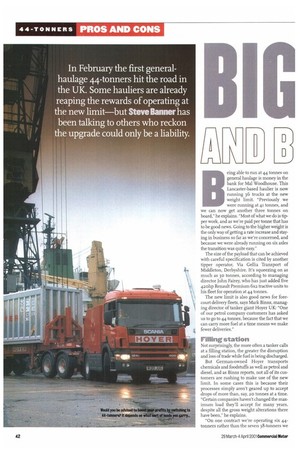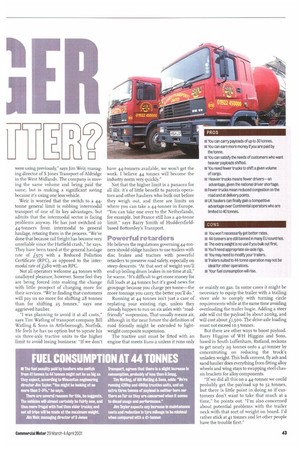eing able to run at 44 tonnes on general haulage
Page 44

Page 45

If you've noticed an error in this article please click here to report it so we can fix it.
is money in the bank for Mal Woodhouse. This Lancaster-based haulier is now running 36 trucks at the new weight limit "Previously we were running at 41 tonnes, and we can now get another three tonnes on board," he explains. "Most of what we do is tipper work, and as we're paid per tonne that has to be good news. Going to the higher weight is the only way of getting a rate increase and staying in business so far as we're concerned, and because we were already running on six axles the transition was quite easy."
The size of the payload that can be achieved with careful specification is cited by another tipper operator, Via Gellia Transport of Middleton, Derbyshire. It's squeezing on as much as 30 tonnes, according to managing director John Fairey, who has just added five 4zohp Renault Premium 6x2 tractive units to his fleet for operation at 44 tonnes.
The new limit is also good news for forecourt delivery fleets, says Mark Binns, managing director of tanker giant Hoyer UK: 'One of our petrol company customers has asked us to go to 44 tonnes, because the fact that we can carry more fuel at a time means we make fewer deliveries."
Filling station
Not surprisingly, the more often a tanker calls at a filling station, the greater the disruption arid loss of trade while fuel is being discharged But German-owned Hoyer transports chemicals arid foodstuffs as well as petrol and diesel, and as Birms reports, not all of its customers are rushing to make use of the new limit In some cases this is because their processes simply aren't geared up to accept drops of more than, say, zo tonnes at a time. "Certain companies haven't changed the maximum load they'll accept for many years, despite all the gross weight alterations there have been," he explains.
"On one contract we're operating SiX 44
were using previously," says Jim Weir, managing director of S Jones Transport of Aldridge in the West Midlands. The company is moving the same volume and being paid the same, but is making a significant saving because it's using one less vehicle.
Weir is worried that the switch to a 44tonne general limit is robbing interrnodal transport of one of its key advantages, but admits that the interrnodal sector is facing problems anyway. He has just switched ro 44-tonners from intermodal to general haulage, retaxing them in the process. "We've done that because rail freight has become very unreliable since the Hatfield crash," he says. They have been taxed at the general haulage rate of Z.975 with a Reduced Pollution Certificate (RPC), as opposed to the inter. modal rate of f28o with an RPC.
Not all operators welcome 44 tonnes with unalloyed pleasure, however. Some feel they are being forced into making the change with little prospect of charging more for their services. "We're finding that customers will pay us no more for shifting 28 tonnes than for shifting 25 tonnes," says one aggrieved haulier.
"I was planning to avoid it at all costs," says Tim Watling of transport company Bill Watling gc Sons in Attleborough, Norfolk. He feels he has no option but to uprate his S r X three-axle tractive units to the higher limit to avoid losing business: "If we don't
have 44-tonners available, we won't get the work. I believe 44 tonnes will become the industry norm very quickly."
Not that the higher limit is a panacea for all ills: it's of little benefit to parcels operators and other hauliers who bulk out before they weigh out, and there are limits on where you can take a 44-tonner in Europe. You can take one over to the Netherlands, for example, but France still has a 40-tonne limit," says Barry Smith of Huddersfieldbased Bottomley's Transport.
Powerful retarders
He believes the regulations governing 44-100ners should oblige hauliers to use trailers with disc brakes and tractors with powerful retarders to preserve road safety, especially on steep descents. "At that sort of weight you'll end up boiling drum brakes in no time at all," he warns. "It's difficult to get more money for full loads at 44 tonnes but it's good news for groupage because you charge per tonne—the more tonnage you carry, the better you'll do."
Running at 44 tonnes isn't just a case of replating your existing rigs, unless they already happen to run on six axles with "roadfriendly" suspension. That usually means air, although in the near future the definition of road friendly might be extended to lightweight composite suspension.
The tractive unit must be fitted with an engine that meets Euro.2 unless it runs only
• You can carry payloads of up to 30 tonnes.
• You can earn more money if you are paid by the tonne.
NI You can satisfy the needs of customers who want heavier payloads shifted.
• You need fewer trucks to shift a given volume of cargo.
is Heavier trucks means fewer drivers—an advantage, given the national driver shortage. III Fewer trucks mean reduced congestion on the road and at delivery points.
MIX hauliers can finally gain a competitive advantage over Continental operators who are limited to 40 tonnes.
• You won't necessarily get better rates.
• 44-tonners are still banned in many EU countries.
• The extra weight is no use if you bulk out first.
• You'll need appropriate six-axle rigs.
• You may need to modify your trailers.
• Trailers suited to 44-tonne operation may not be ideal for other operations.
• Your fuel consumption will rise.
or mainly on gas. In some cases it might be necessary to equip the trailer with a trailing steer axle to comply with turning circle requirements while at the same time avoiding overloading the trailer bogie. Adding a steer axle will cut the payload by about 2ookg, and will cost about Lt,5o o. The drive-axle loading must not exceed 10.5 tonnes.
But there are other ways to boost payload. Barry Higgins of WH Higgins and Sons, based in South Luffenharn, Rutland, reckons to get nearly 29 tonnes onto a 41.tonner by concentrating on reducing the truck's unladen weight. This bulk cement, fly ash and sand haulier does everything from fitting alloy wheels and wing stays to swapping steel chassis brackets for alloy components.
"If we did all this on a 44-tanner we could probably get the payload up to 32 tonnes, but there is little point in doing so if customers don't want to take that much at a time," he points out. "I'm also concerned about potential problems with the trailer neck with that sort of weight on board. I'd rather stick at 41 tonnes and let other people have the trouble first."








































































































